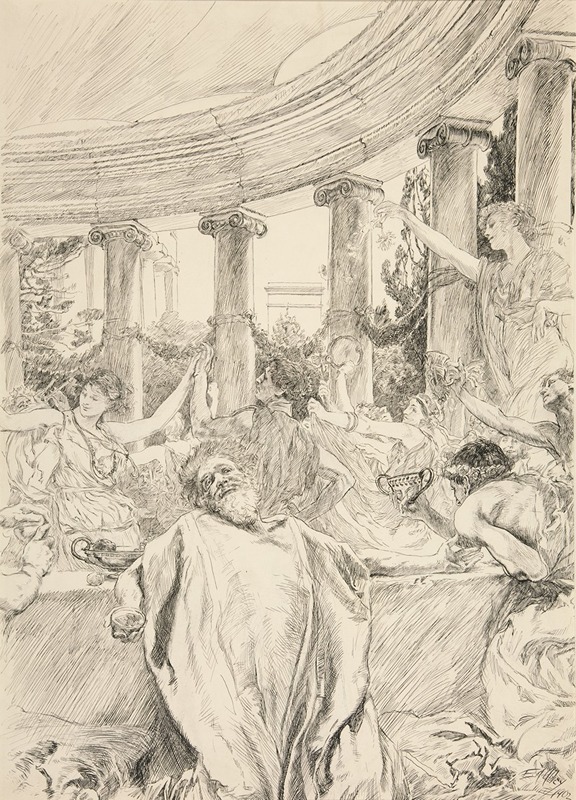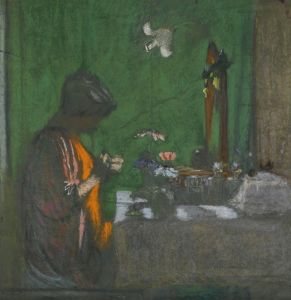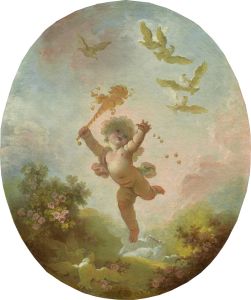
Apemantus; “Hoy-day! what a sweep of vanity comes this way! They dance! They are mad women!” – Act I, Scene II, Timon of Athens
A hand-painted replica of Edwin Austin Abbey’s masterpiece Apemantus; “Hoy-day! what a sweep of vanity comes this way! They dance! They are mad women!” – Act I, Scene II, Timon of Athens, meticulously crafted by professional artists to capture the true essence of the original. Each piece is created with museum-quality canvas and rare mineral pigments, carefully painted by experienced artists with delicate brushstrokes and rich, layered colors to perfectly recreate the texture of the original artwork. Unlike machine-printed reproductions, this hand-painted version brings the painting to life, infused with the artist’s emotions and skill in every stroke. Whether for personal collection or home decoration, it instantly elevates the artistic atmosphere of any space.
Edwin Austin Abbey's painting, inspired by William Shakespeare's play "Timon of Athens," specifically Act I, Scene II, captures a moment of dramatic intensity and social commentary. Abbey, an American artist known for his illustrations and paintings, often drew inspiration from literary sources, particularly Shakespearean works. This painting is a testament to his ability to translate the written word into visual art, capturing the essence of the characters and the themes they embody.
In "Timon of Athens," Apemantus is a character known for his cynical and critical view of Athenian society. The line "Hoy-day! what a sweep of vanity comes this way! They dance! They are mad women!" reflects Apemantus's disdain for the superficiality and excess he observes. Abbey's painting likely seeks to encapsulate this moment, illustrating the contrast between Apemantus's critical perspective and the ostentatious behavior of the Athenian elite.
Abbey's work is characterized by its attention to detail and historical accuracy, often incorporating elements of the period's attire and architecture to create an authentic representation. His Shakespearean paintings are noted for their rich color palettes and dynamic compositions, which bring the scenes to life and engage the viewer in the narrative.
The painting would have been created during a period when Abbey was deeply involved in illustrating Shakespearean themes, a pursuit that occupied much of his career. Abbey's dedication to this subject matter is evident in his meticulous approach to capturing the nuances of Shakespeare's characters and the societal critiques embedded within the plays.
Abbey's interpretation of "Timon of Athens" would have been informed by his extensive study of Shakespeare's works and his understanding of the cultural and historical context in which the play was written. His ability to convey complex themes through visual art made him a prominent figure in the art world, particularly in the realm of literary illustration.
While specific details about the painting's creation, such as the exact date or the circumstances under which it was commissioned, may not be readily available, it is clear that Abbey's work continues to be appreciated for its artistic merit and its contribution to the visual interpretation of Shakespearean literature.
Overall, Edwin Austin Abbey's painting of Apemantus's line from "Timon of Athens" serves as a bridge between literature and visual art, offering viewers a glimpse into the timeless themes of vanity and folly that Shakespeare so masterfully explored. Abbey's legacy as an artist is marked by his ability to bring these themes to life, ensuring that they remain relevant and accessible to audiences across generations.

















![Rejoice, Carnival, for Tomorrow Thou Wilt Be Ashes [Carnival Folly]](/imgs/264649/s/francisco-de-goya-rejoice-carnival-for-tomorrow-thou-wilt-be-ashes-carnival-folly-5d37f315.jpg)
